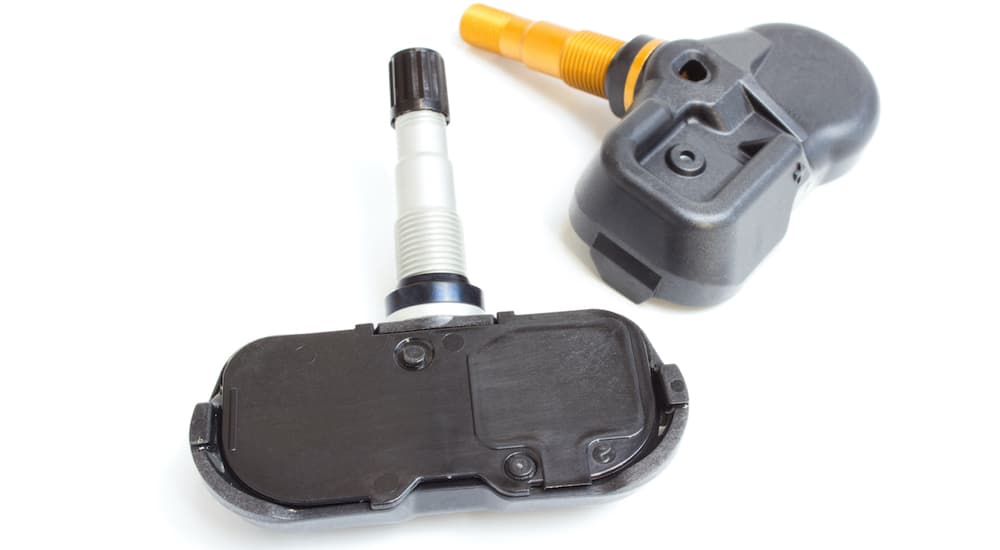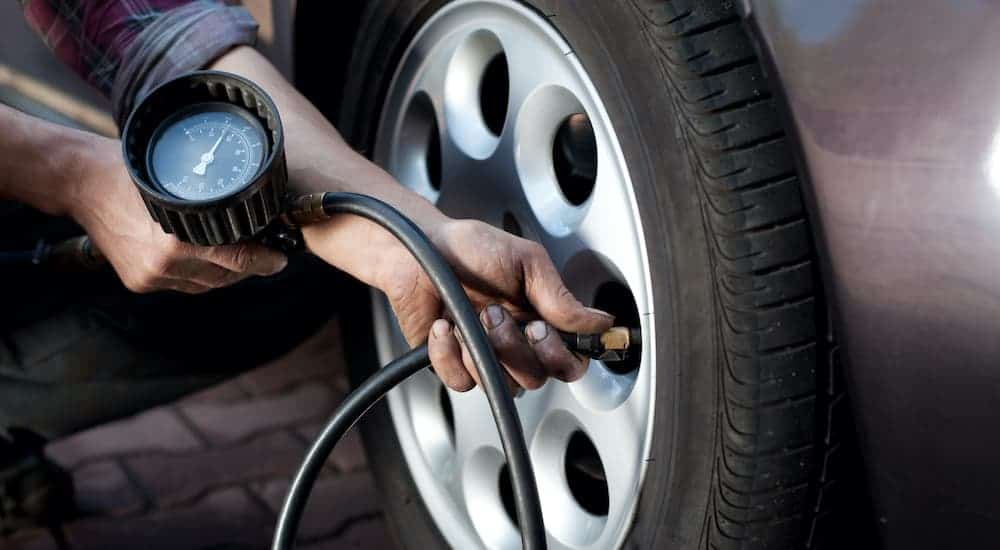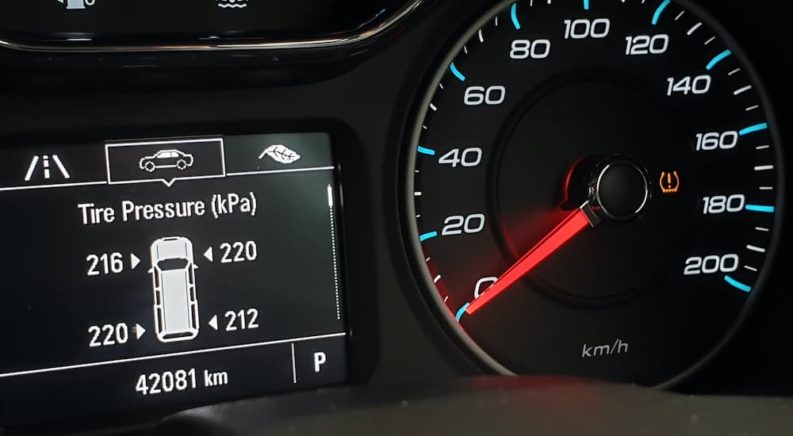A tire blowout is one of the most jarring events a driver can imagine. It can be heartstopping when the tire goes, and you have to try to safely maneuver to the side of the road. Fortunately, since 2008 virtually every new vehicle has been provided with a tire pressure monitoring system (TPMS), so you’ll always have confidence that your tires are pressurized. You shouldn’t ignore the TPMS light when it comes on, but you don’t need to hurry to your local discount tire shop right away either. If you understand how your TPMS system works, you can take necessary action right away to protect yourself before escalating to a service visit.
A tire pressure monitoring system works by recording wheel speed, temperature, and pressure, transmitting that data to the onboard computer, and comparing it to the programmed standards. If the comparison indicates that the actual tire pressure is below 75% of the recommended pressure, the warning light will come on.
The inclusion of this system on all cars manufactured since 2008 was mandated by the Transportation Recall Enhancement, Accountability and Documentation Act (TREAD Act) of Congress in response to a string of fatal accidents in the late 1990s. The accidents, which disproportionately affected Ford Explorers equipped with Firestone tires, were caused by blowouts due to low tire pressure and resulted in over 100 deaths. The inclusion of TPMS means every driver will be alerted to low tire pressure conditions when they occur, so they can correct the situation before it leads to a disaster. But what exactly is the TPMS doing while you drive?
Two Means to an End
There are two ways that manufacturers incorporate a TPMS design: direct and indirect.
Direct System
A direct TPMS system uses a sensor to directly measure the air pressure inside the tire. Typically mounted directly to the valve stem assembly on the inside of the tire, these rugged sensors use a pressure-sensitive microelectromechanical system (MEMS) to make a measurement of air pressure in units of psi. The sensors then use a radio frequency to transmit that measurement along with a unique sensor ID. Some designs are also capable of measuring the air temperature inside the tire, which directly influences pressure and can help determine if the loss pressure is a result of weather or a leak.
The vehicle’s onboard computer receives signals from nearby TPMS sensors and uses the unique sensor IDs to assign pressure readings to corresponding tires. Unrecognized IDs will be ignored so that cars won’t use data from nearby vehicles by mistake. This also means that the system does not need to be reset after rotating the tires since the unique IDs will be coming from new locations.
The data is then interpreted against a pre-programmed recommended pressure level. Let’s say it’s 32 psi as an example. If the reading is 30 psi, then all is well, and there won’t be a warning light. Most systems generate a warning if pressure drops to 75% of the recommended level – in this example, that’s 24 psi. If any sensor reports 24 psi or less, this example system will activate the horseshoe-shaped warning light on the dash.
Direct systems are fairly simple to resynchronize after mounting or rotating the tires, although the equipment to synchronize and service them can be fairly expensive. Although the sensor batteries can’t be replaced, they last for up to a decade, making the full sensor replacements an infrequent service. Ultimately, despite those limitations, direct systems are generally preferred because they give consistent readings with few sources of error.

Indirect System
An indirect system measures something other than pressure and uses that measurement to make an assumption about the tire pressure. That measurement is the tire speed, taken using the anti-lock braking system (ABS) sensors. The ABS uses wheel speed sensors to ensure that the wheels continue spinning during hard braking. An indirect TPMS borrows that reading to infer the tire pressure status.
A properly inflated tire will be a given size, and the wheel speed depends on that size. At any given vehicle speed, a small tire will have a greater wheel speed than a large tire. In simpler terms, if the circumference of a large tire is 10 feet and the vehicle is traveling at 10 feet per second, the wheel speed will be 1 rotation per second. For a small tire with a circumference of 5 feet at the same 10 feet per second velocity, the wheel speed is 2 rotations per second. If the diameter of the tire changes, so does the wheel speed at a given vehicle speed.
The exact diameter of a tire depends on the vehicle weight, tire design, and actual pressure. The system will be programmed to understand what “normal” wheel speed is. The onboard computer will look for warning signs such as one wheel operating at a different rate from the others or any wheel operating at unusually high speed. Internal calculations will correlate a certain increase in wheel speed to a 25% loss of pressure, triggering the TPMS warning light.
Indirect systems are relatively inexpensive to install and maintain, but they are prone to error since tire diameter is influenced by factors other than pressure. Treadwear – especially uneven wear – will reduce the diameter, simulating low pressure. Changing the tires at any time is very likely to change the diameter as well. Even routine maintenance such as tire rotation or tire inflation will affect the system, as both activities change the diameter in every corner. As a result, indirect TPMS needs to be resynchronized and reset frequently to maintain accuracy.

Responding to Low Pressure
When it detects a low-pressure tire, the TPMS warning light – the one that looks like a horseshoe with an exclamation mark though is meant to look like a low-pressure tire when viewed from the front or rear – will illuminate. Like your other warning lights, this light will shine when you turn your car on, so you know it’s working. If it stays on, it’s time to take action.
The first thing you should do is use a manual pressure gauge to check the pressure of each tire. Take 2 or 3 measurements each to be sure your reading is accurate. The goal is to identify which tire(s) triggered the warning. Your next step is to inflate all 4 tires to the recommended pressure, usually listed on the driver’s door sill. The tires should all be inflated to the same pressure to promote even performance and wear.
If your warning light turned off while you were driving, that just means that your low tire(s) pressure is right at the 25% warning threshold. As you drive, the tire warms up, and the warmed air inside increases in pressure, which may deactivate the warning. If this happens, give the car a couple of hours to cool down before checking the tire pressures.
Hopefully, this will resolve things for you. However, if the TPMS warning reactivates soon and you find that the same tire(s) is to blame, you’ve got a slow leak on your hands. While diagnosing, finding, and even repairing a slow leak can be a DIY activity, you can always rely on your local garages to handle it for you. However, you choose to proceed, address the slow leak ASAP to eliminate this safety hazard, and maximize the economy of your ride.
You may also get a flashing warning light or a “check system” warning with the TPMS light. These usually indicate a system problem like a dead sensor battery or unrecognized sensors. Qualified mechanics will be able to quickly and efficiently diagnose these issues so you can restore normal TPMS function soon. If you choose to ignore this warning, be aware that you will not get a TPMS warning for low pressure and need to manually check the tire pressures yourself on a regular basis to ensure safety. You should do this at least once a week if your system is broken.
Pay Attention to the Warning Lights
While installing and maintaining direct TPMS sensors is best left to the professionals, understanding how they work is helpful for understanding the health of your vehicle. If you’re the hands-on type, there’s also a lot that you can do in response to a TPMS warning since DIY tire repairs are quite doable. Above all, understand that the TPMS is there for the sole purpose of helping you to keep yourself safe, making it easier than ever to know when tire maintenance is necessary. That knowledge is power – don’t waste it!

